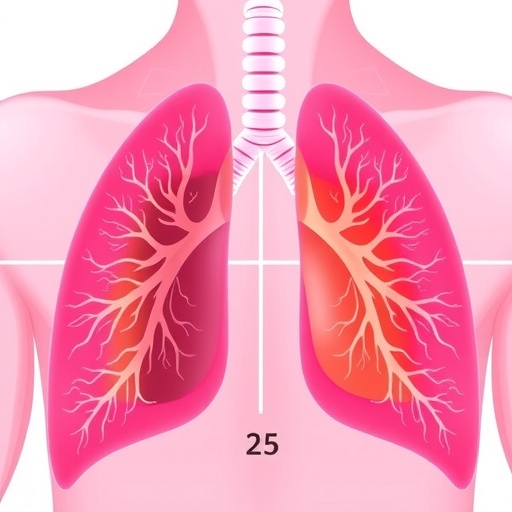In a groundbreaking study spearheaded by the Barcelona Institute for Global Health (ISGlobal), supported by the ”la Caixa” Foundation and carried out in collaboration with Clínic-IDIBAPS, researchers have unveiled novel insights into the evolution of lung capacity across the human lifespan. Published in The Lancet Respiratory Medicine, this extensive analysis reshapes foundational understandings by charting lung function trajectories from early childhood through old age, offering a transformative framework that may redefine how clinicians and public health officials monitor respiratory health globally.
Traditionally, the prevailing consensus held that lung function increased steadily until reaching its peak between the ages of 20 and 25. Following this, lung capacity was believed to remain relatively stable for an extended period before commencing a gradual decline linked to the physiological aging process of the lungs. This longstanding model, however, was constructed on data sets that failed to encompass the entire human age spectrum, leaving significant gaps in comprehension, particularly concerning the transitions between life stages.
Employing an innovative “accelerated cohort design,” the researchers amalgamated data from eight major population-based cohort studies across Europe and Australia. This unique approach allowed the team to assemble lung function information from over 30,000 individuals ranging in age from 4 to 82 years. The exhaustive dataset enabled unprecedented resolution in identifying nuanced shifts in lung capacity that previous investigations could not capture. Forced spirometry—a technique where subjects exhale forcefully after a maximal inhalation—served as the gold standard measurement tool, quantifying critical parameters such as forced expiratory volume in one second (FEV1) and forced vital capacity (FVC). Alongside spirometric data, detailed information regarding participants’ smoking habits and asthma status was meticulously recorded to contextualize findings.
A defining revelation of the study is the biphasic nature of lung growth. Initial results underscore a rapid lung function surge during childhood, a period marked by swift physiological development. This phase is followed by a secondary, more protracted phase characterized by slower lung volume increases that culminate in peak lung capacity. The differentiation between these two growth stages provides a granular perspective on respiratory development, aligning with known patterns of bodily maturation yet highlighting the complex interplay of growth rates and environmental influences on lung health.
The trajectory of lung function also turned out to be sex-dependent. While women generally reach their maximal FEV1 at approximately 20 years of age, men tend to peak slightly later, around 23 years. Crucially, and contrary to previous models which posited a lengthy plateau phase post-peak, the data revealed an immediate decline in lung function following the apex, with no stabilization period in between. This paradigm shift challenges entrenched clinical assumptions and introduces the possibility that lung deterioration begins much earlier than previously recognized.
Moreover, the study elucidated the differentiated impacts of chronic respiratory conditions and lifestyle factors on lung trajectories. Persistent asthma was linked to a notably earlier peak in FEV1 values, accompanied by lower lung function levels throughout the lifespan. This finding accentuates the systemic burden asthma places on pulmonary health from an early age, reinforcing the critical importance of early diagnosis and management. Smoking, by contrast, manifested as a factor contributing principally to an accelerated decline in lung function beginning around the age of 35. The data affirm that smoking’s deleterious effects are time-dependent and compound lung function loss beyond natural aging processes.
These insights carry profound public health implications. The immediate post-peak decline in lung function underscores the urgency in adopting early, proactive screening strategies utilizing spirometry, especially among populations at risk due to asthma or smoking exposure. Detecting diminished lung capacity in youth and early adulthood opens a valuable window for timely interventions aimed at mitigating progression toward chronic respiratory diseases, which remain leading contributors to global morbidity and mortality.
Clinicians, too, are encouraged to reassess monitoring frameworks for respiratory health. Lung function trajectories illuminated in this study suggest that waiting until mid-adulthood to target lung health may be suboptimal. Instead, continuous surveillance beginning in early life stages could substantially improve patient outcomes by enabling preventative and therapeutic strategies tailored to individual lung function patterns and risk exposures.
Technically, the use of forced spirometry in multiple cohorts guarantees robustness of lung function measurements, yet the accelerated cohort design represents a methodological leap, synthesizing heterogeneous datasets to build a comprehensive life course profile. This design circumvents the temporal limitations inherent in single-cohort longitudinal studies and allows for a dynamic understanding of age-associated physiological changes with enhanced statistical power.
The involvement of more than 30,000 participants spanning nearly eight decades of life adds both statistical weight and demographic diversity to the findings, improving their generalizability across populations in Western Europe and Australia. Inclusion criteria encompassed children, adolescents, adults, and seniors, facilitating a holistic depiction of lung function lifespan dynamics that integrates growth, maturation, and aging processes.
In terms of the physiological underpinnings, the immediate post-peak decline may reflect complex alterations in lung elasticity, airway remodeling, and cellular senescence that commence earlier than previously suspected. Meanwhile, persistent asthma’s early impact may be mediated by chronic airway inflammation and structural lung changes that prevent typical growth trajectories. Similarly, smoking’s acceleration of decline aligns with established associations between tobacco exposure and increased oxidative stress, airway obstruction, and emphysematous damage.
The findings open new avenues for research exploring molecular and environmental determinants modulating lung function trajectories. Understanding why plateau phases are absent might stimulate investigations into early subclinical respiratory deterioration and underscore the need for integrating lung health into wider preventive health policies.
In conclusion, this pioneering research transcends traditional paradigms, offering an enriched understanding of lung function’s evolution across life stages. The evidence emphasizes the critical importance of early lung health surveillance, particularly for individuals burdened by respiratory diseases or harmful exposures. By adopting this refined perspective, healthcare systems can better allocate resources to forestall chronic pulmonary diseases and improve quality of life worldwide.
Subject of Research: People
Article Title: General Population-Based Lung Function Trajectories Over The Life Course. An Accelerated Cohort Study
Web References: http://dx.doi.org/10.1016/S2213-2600
References: Garcia-Aymerich, J., de las Heras, M., Carsin, A.-E., Accordini, S., Agustí, A., Bui, D., C Dharmage, S., W Dodd, J., Eze, I., Gehring, U., Gislason, T., Granell, R., Imboden, M., Íñiguez, C., Jeong, A., Koch, S., H Koppelman, G., Leynaert, B., Melén, E., … Faner, R. (n.d.). General Population-Based Lung Function Trajectories Over The Life Course. An Accelerated Cohort Study. The Lancet Respiratory Medicine, 2025.
Keywords: Lungs, Cohort studies, Asthma, Smoke, Risk factors
Tags: age-related lung function changesBarcelona Institute for Global Healthcohort study analysisearly adulthood lung healthglobal health implicationsinnovative research methodologieslung capacity declinelung function trajectoriesphysiological aging of lungspublic health monitoringrespiratory health across lifespantransformative healthcare insights





